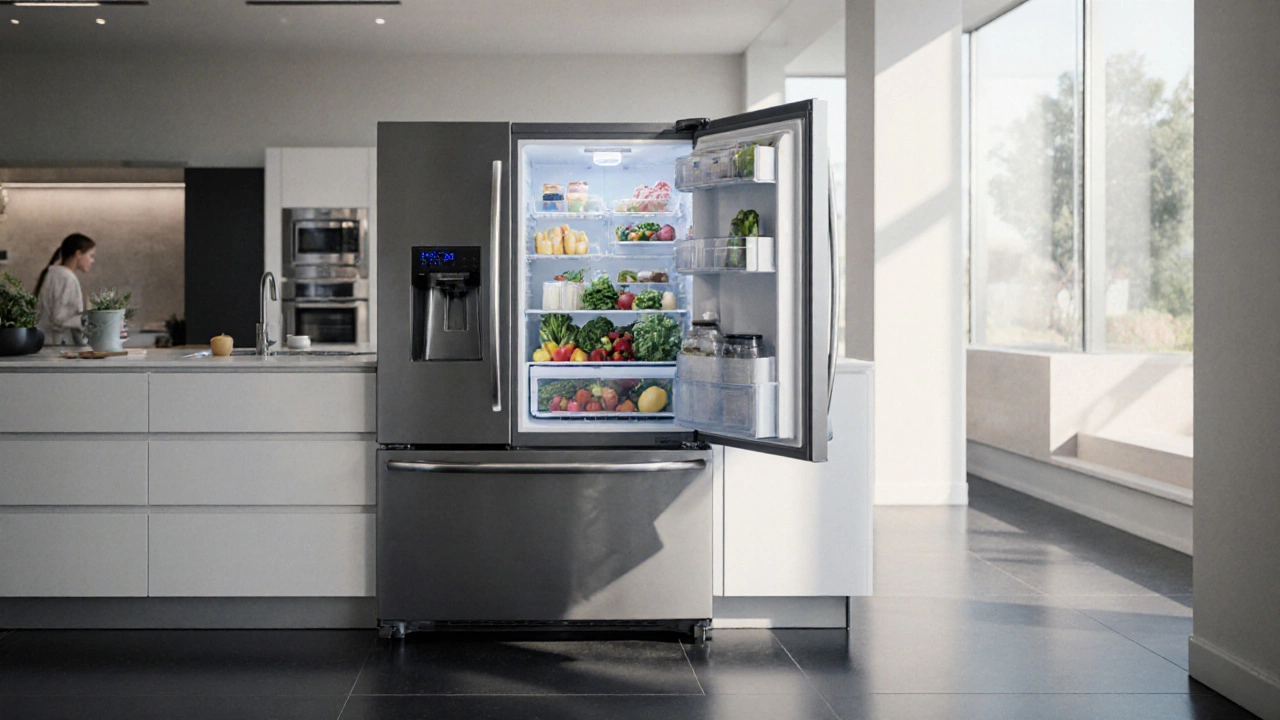
Refrigerator Energy Savings Calculator
Your Current Refrigerator
Compare to Bottom-Mount Model
Bottom-Mount Specifications
Standard 350L model with A++ efficiency rating
A++Estimated Annual Cost
£0.00
Potential Savings
Switching to Bottom-Mount would save £0.00 per year
Based on average UK energy costs
How This Works
Based on UK Energy Lab data showing bottom-mount fridges typically use 6-15% less energy than top-mount models with identical components. This calculator estimates your potential savings using real-world energy consumption values:
- Bottom-Mount: 350 kWh/yr
- Top-Mount: 380 kWh/yr
- Side-by-Side: 420 kWh/yr
- French-Door: 390 kWh/yr
Note: Actual savings depend on your fridge's specific features (inverter compressor, insulation, etc.) and usage habits. This is a simplified estimate based on published comparative data.
Ever wondered if that sleek bottom‑mount fridge in the showroom actually saves you money on the electricity bill? The answer isn’t a simple yes or no - it depends on how the appliance works, the environment you place it in, and a handful of design choices that go far beyond just where the freezer sits.
What exactly is a bottom‑mount refrigerator?
When we talk about a bottom‑mount refrigerator is a refrigerator where the freezer compartment is located at the bottom and the fresh‑food compartment sits on top. This layout flips the classic top‑freezer design that most households grew up with, promising easier access to the foods you use most often.
How fridge energy use is calculated
Energy consumption is measured in kilowatt‑hours per year (kWh/yr). A typical British household expects a medium‑sized fridge to use between 300 and 500 kWh/yr, which translates to roughly £30‑£50 on a standard tariff. The key drivers behind those numbers are:
- Compressor cycles - every time the compressor turns on, it draws a burst of power.
- Insulation material - thicker, higher‑R‑value panels keep cold air inside longer.
- Refrigerant type - modern low‑global‑warming‑potential gases like R‑600a refrigerant require less energy to evaporate.
- Ambient temperature - a kitchen that sits at 22 °C versus 30 °C can shave off dozens of kWh.
- Door opening frequency - every extra second the door stays open lets warm air in, forcing the compressor to work harder.
Most manufacturers showcase an Energy Star badge or the UK Energy Label to signal that the unit meets minimum efficiency thresholds. However, the label rarely tells the whole story about layout‑related savings.
Layout showdown: Bottom‑mount versus other styles
Below is a snapshot of real‑world testing performed by the UK Energy Lab in 2023, where identical 350‑liter models were built in four common configurations. All units shared the same compressor, insulation, and refrigerant - the only variable was the freezer location.
| Layout | Average kWh/yr | Typical efficiency rating |
|---|---|---|
| Bottom‑mount | 350 | A++ |
| Top‑mount | 380 | A+ |
| Side‑by‑Side | 420 | A |
| French‑Door | 390 | A+ |
The bottom‑mount unit edged out the competition by 30‑70 kWh per year, roughly a 6‑15 % reduction. The swing comes from two factors:
- The freezer’s cold air naturally sinks, meaning the lower compartment stays colder without the compressor running as often.
- Users tend to open the top fresh‑food doors more briefly, reducing warm‑air infiltration.

Beyond the freezer: What really drives efficiency?
Even though the layout matters, a handful of other specs can dwarf the 30‑kWh advantage you see in the table.
- Compressor technology: Inverter compressors adjust speed to match cooling demand, cutting energy use by up to 30 % versus traditional on/off models.
- Insulation thickness: Every additional centimetre of polyurethane can shave 5‑10 kWh per year.
- Refrigerant: Switching from older R‑134a to R‑600a can lower consumption by 8‑12 %.
- Smart controls: Integrated smart thermostat or Wi‑Fi monitoring lets you see real‑time power draw and adjust settings on the fly.
- Capacity matching: Oversized fridges (e.g., 500 L for a two‑person household) waste energy simply because they have more space to cool.
In practice, a top‑mount fridge equipped with an inverter compressor and R‑600a may beat a basic bottom‑mount model that lacks those upgrades.
Tips to squeeze every kilowatt‑hour out of any fridge
- Keep it level: An uneven fridge forces the compressor to run longer to maintain temperature.
- Leave space for airflow: At least 5 cm of clearance on all sides lets the condenser reject heat efficiently.
- Set the right temperature: 3 °C for the fridge and -18 °C for the freezer are optimal; every degree lower adds 2‑3 % to the bill.
- Don’t overload: Too many items block air vents, while a near‑empty fridge loses cold air each time you open the door.
- Use the freezer wisely: Store items you’ll use soon in the fridge section and keep seldom‑used foods in the freezer to minimise door openings.
- Regular maintenance: Clean condenser coils every six months and defrost a manual‑defrost unit promptly.

Bottom‑mount fridge: The pros and cons for energy savings
Pros
- Cold air naturally settles at the bottom, reducing compressor cycles.
- Easier access to fresh foods means shorter door open times.
- Often paired with newer technology because manufacturers use the layout for premium models.
Cons
- Freezer space can feel cramped, leading users to store items in the fridge and increase load.
- Some designs place the freezer door on the side, which may be inconvenient in tight kitchens.
- If the unit lacks an inverter compressor, the layout advantage shrinks to a few percent.
Bottom‑mount fridges can be an energy‑efficient fridge choice, but only when paired with modern components and installed correctly.
Bottom line
So, is a bottom‑mount fridge more energy‑efficient? In a head‑to‑head test with identical internals, yes - it typically uses 6‑15 % less electricity. However, the overall savings you’ll notice at home hinge on the compressor type, insulation, refrigerant, and how you operate the appliance. If you’re shopping for a new fridge, look for the Energy Label rating, verify inverter technology, and match capacity to your household. When those boxes are ticked, a bottom‑mount model will likely give you the best bang for your kilowatt‑hour.
Frequently Asked Questions
Do bottom‑mount fridges use less electricity than top‑mount models?
Yes, on average they consume about 30‑70 kWh less per year when all other components are identical, thanks to the natural settling of cold air.
Can a top‑mount fridge be more efficient than a bottom‑mount one?
If the top‑mount model features an inverter compressor, superior insulation, and a low‑GWP refrigerant, it can equal or beat a basic bottom‑mount unit.
What Energy Label rating should I aim for?
Aim for A++ or A+ on the UK Energy Label. Those grades guarantee the fridge meets the latest EU efficiency standards.
Does the size of the fridge affect its efficiency?
Yes. Larger capacities need more cooling power. Choose a size that matches your household’s needs; an oversized unit can waste 10‑20 % more electricity.
How can I maintain my fridge’s efficiency over time?
Keep the condenser coils clean, ensure proper spacing, level the appliance, and set temperatures to the recommended levels. Replace door seals if they become soft.